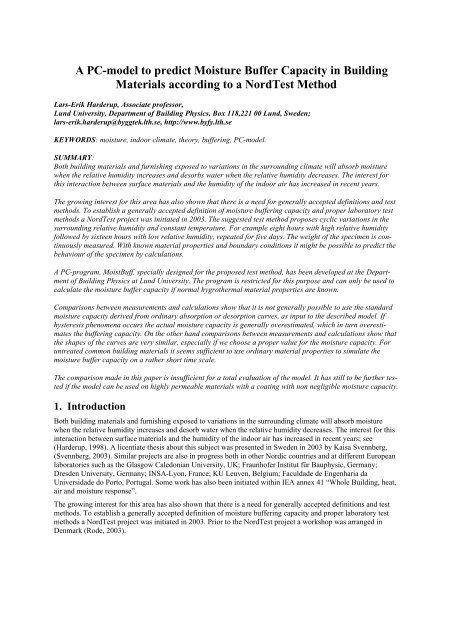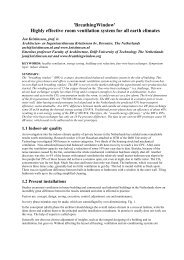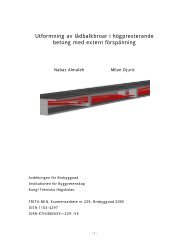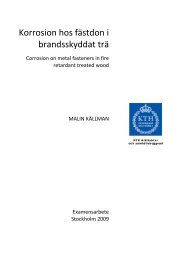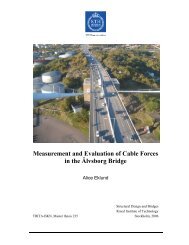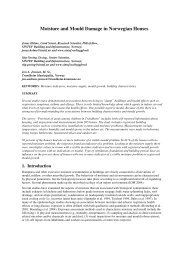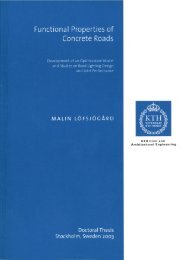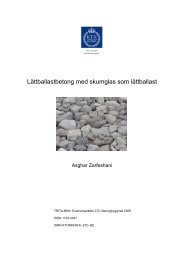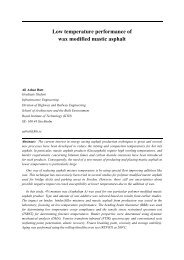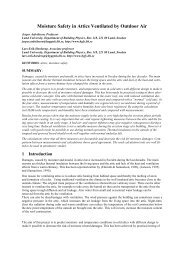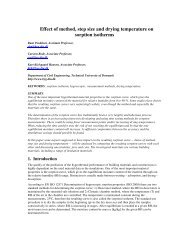Read complete article here
Read complete article here
Read complete article here
You also want an ePaper? Increase the reach of your titles
YUMPU automatically turns print PDFs into web optimized ePapers that Google loves.
A PC-model to predict Moisture Buffer Capacity in Building<br />
Materials according to a NordTest Method<br />
Lars-Erik Harderup, Associate professor,<br />
Lund University, Department of Building Physics, Box 118,221 00 Lund, Sweden;<br />
lars-erik.harderup@byggtek.lth.se, http://www.byfy.lth.se<br />
KEYWORDS: moisture, indoor climate, theory, buffering, PC-model.<br />
SUMMARY:<br />
Both building materials and furnishing exposed to variations in the surrounding climate will absorb moisture<br />
when the relative humidity increases and desorbs water when the relative humidity decreases. The interest for<br />
this interaction between surface materials and the humidity of the indoor air has increased in recent years.<br />
The growing interest for this area has also shown that t<strong>here</strong> is a need for generally accepted definitions and test<br />
methods. To establish a generally accepted definition of moisture buffering capacity and proper laboratory test<br />
methods a NordTest project was initiated in 2003. The suggested test method proposes cyclic variations in the<br />
surrounding relative humidity and constant temperature. For example eight hours with high relative humidity<br />
followed by sixteen hours with low relative humidity, repeated for five days. The weight of the specimen is continuously<br />
measured. With known material properties and boundary conditions it might be possible to predict the<br />
behaviour of the specimen by calculations.<br />
A PC-program, MoistBuff, specially designed for the proposed test method, has been developed at the Department<br />
of Building Physics at Lund University. The program is restricted for this purpose and can only be used to<br />
calculate the moisture buffer capacity if normal hygrothermal material properties are known.<br />
Comparisons between measurements and calculations show that it is not generally possible to use the standard<br />
moisture capacity derived from ordinary absorption or desorption curves, as input to the described model. If<br />
hysteresis phenomena occurs the actual moisture capacity is generally overestimated, which in turn overestimates<br />
the buffering capacity. On the other hand comparisons between measurements and calculations show that<br />
the shapes of the curves are very similar, especially if we choose a proper value for the moisture capacity. For<br />
untreated common building materials it seems sufficient to use ordinary material properties to simulate the<br />
moisture buffer capacity on a rather short time scale.<br />
The comparison made in this paper is insufficient for a total evaluation of the model. It has still to be further tested<br />
if the model can be used on highly permeable materials with a coating with non negligible moisture capacity.<br />
1. Introduction<br />
Both building materials and furnishing exposed to variations in the surrounding climate will absorb moisture<br />
when the relative humidity increases and desorb water when the relative humidity decreases. The interest for this<br />
interaction between surface materials and the humidity of the indoor air has increased in recent years; see<br />
(Harderup, 1998). A licentiate thesis about this subject was presented in Sweden in 2003 by Kaisa Svennberg,<br />
(Svennberg, 2003). Similar projects are also in progress both in other Nordic countries and at different European<br />
laboratories such as the Glasgow Caledonian University, UK; Fraunhofer Institut für Bauphysic, Germany;<br />
Dresden University, Germany; INSA-Lyon, France; KU Leuven, Belgium; Faculdade de Engenharia da<br />
Universidade do Porto, Portugal. Some work has also been initiated within IEA annex 41 “Whole Building, heat,<br />
air and moisture response”.<br />
The growing interest for this area has also shown that t<strong>here</strong> is a need for generally accepted definitions and test<br />
methods. To establish a generally accepted definition of moisture buffering capacity and proper laboratory test<br />
methods a NordTest project was initiated in 2003. Prior to the NordTest project a workshop was arranged in<br />
Denmark (Rode, 2003).
Several different ways of defining moisture buffer capacity have been suggested. Most of them use well established<br />
material properties, such as; moisture capacities, water vapour permeability and density to calculate some<br />
kind of moisture buffer value. Since the moisture buffer capacity is generally derived from other material properties,<br />
the time scale is also an important factor. Some materials have very high buffering capacity if examined on<br />
short time scales (hours, days) while other materials have considerable buffering capacity on long time scales<br />
(month, years). Generally, we are only interested in materials with high or moderate moisture capacity on a<br />
relatively short time scale.<br />
The suggested test method proposes cyclic variations in the surrounding relative humidity and constant temperature.<br />
For example eight hours with high relative humidity followed by sixteen hours with low relative humidity,<br />
repeated for five days. The weight of the specimen is continuously measured. With known material properties<br />
and boundary conditions it might be possible to predict the behaviour of the specimen by calculations.<br />
A PC-program, MoistBuff, especially designed for the proposed test method, has been developed at the Department<br />
of Building Physics at Lund University. The program is restricted for this purpose and can only be used to<br />
calculate the moisture buffer capacity if normal material data are known. Theory and results from validations are<br />
presented in this paper.<br />
2. Nomenclature<br />
Bi Biot number -<br />
Bn Coefficient -<br />
c Specific heat capacity J/(kg·K)<br />
d Relative thickness for the surface layer m<br />
ds Thickness of the surface layer m<br />
Dw Moisture diffusivity m²/s<br />
gv Density of moisture flow rate kg/(m²·s)<br />
G’ Dimensionless accumulated flow -<br />
Gv Accumulated moisture flow kg/m²<br />
L Thickness of the slab m<br />
m Mass kg<br />
M Molar weight kg/kmole<br />
p Pressure Pa<br />
R Molar gas constant = 8314,3 J/(kmole·K)<br />
t Time s<br />
T Temperature °C; K<br />
u Dimensionless vapour concentration -<br />
v Vapour concentration kg/m³<br />
vs Vapour concentration at saturation point kg/m³<br />
V Volume m³<br />
w Moisture content kg/m³<br />
Z Water vapour resistivity (d/δ) s/m<br />
Zs Water vapour resistivity for the surface layer s/m<br />
δs Permeability to vapour for the surface layer m²/s<br />
δv Permeability to vapour m²/s<br />
ϕ Relative humidity -<br />
μn Exponential factor -<br />
ρ Density kg/m³<br />
τ Dimensionless time -<br />
ξ Moisture capacity kg/m³<br />
ξ’ Moisture capacity -<br />
3. Theory<br />
Assuming that the vapour concentration is the only potential for moisture flow the following equation can be<br />
applied:
By writing<br />
∂w<br />
= −<br />
∂t<br />
∂<br />
∂x<br />
( g )<br />
v<br />
0 < x
∂v<br />
∂x<br />
= 0<br />
x = L (10)<br />
v1<br />
− v ∂v<br />
= −δ<br />
v ⋅ x = 0 (11)<br />
Z ∂x<br />
s<br />
v ( x,<br />
0)<br />
= v 0 < x < L (12)<br />
By rewriting Eqn. 11 we have<br />
∂v<br />
v1 = v − δ v ⋅ Z s ⋅<br />
∂x<br />
0<br />
x = 0 (13)<br />
In a dimensionless expression the vapour concentration can be written as<br />
w<strong>here</strong><br />
( v − v ) u(<br />
x',<br />
τ )<br />
v( x,<br />
t)<br />
= v0<br />
+ 1 0 ⋅<br />
(14)<br />
x<br />
x ' =<br />
(15)<br />
L<br />
Dw ⋅t<br />
δ v ⋅t<br />
τ = =<br />
(16)<br />
2<br />
2<br />
L ξ ⋅ L<br />
u(x’,τ) must fulfil the following conditions<br />
2<br />
∂u<br />
∂ u<br />
= 2<br />
∂τ<br />
∂x'<br />
0<br />
' =<br />
∂u<br />
∂x<br />
u1 v<br />
0 < x’ < 1, τ > 0 (17)<br />
x’ = 1 (18)<br />
− u δ ∂u<br />
⋅δ<br />
s = − ⋅ x’ = 0 (19)<br />
d L ∂x'<br />
s<br />
u ( x',<br />
0)<br />
= 0 0 < x’ < 1 (20)<br />
Eqn. 19 can be transformed to<br />
w<strong>here</strong><br />
δ v ⋅ Z<br />
1 = u −<br />
L<br />
L<br />
Bi = =<br />
δ ⋅ Z<br />
v<br />
s<br />
s<br />
∂u<br />
1 ∂u<br />
⋅ = u − ⋅<br />
∂x'<br />
Bi ∂x'<br />
L<br />
d<br />
It can be derived from Eqn. 21 that u only depends on one parameter, Bi the Biot number.<br />
To calculate the accumulated moisture flow as a function of time, Eqn. 24 has to be integrated.<br />
G<br />
g<br />
v<br />
v<br />
=<br />
t<br />
∫<br />
0<br />
g dt'<br />
(23)<br />
v<br />
( v − v )<br />
∂v<br />
δ v ⋅ 1 0 ∂u<br />
= −δ<br />
v ⋅ = − ⋅ x = 0 (24)<br />
∂x<br />
L ∂x'<br />
If Eqn. 23 is expressed with a dimensionless integral we get<br />
( v − v )<br />
δ v ⋅<br />
Gv<br />
=<br />
L ∫<br />
τ<br />
2<br />
1 0<br />
L<br />
⋅<br />
τ<br />
0<br />
∂u<br />
∂x'<br />
( −)<br />
⋅ ( 0,<br />
τ ')<br />
⋅ ⋅d<br />
'<br />
D<br />
w<br />
(21)<br />
(22)<br />
(25)
w<strong>here</strong><br />
2<br />
L<br />
dt'=<br />
⋅dτ<br />
'<br />
(26)<br />
D<br />
Eqn. 25 can now be written<br />
w<br />
τ<br />
δ v ⋅ L<br />
∂u<br />
Gv<br />
=<br />
D<br />
∂x<br />
∫<br />
w<br />
Now we can write<br />
w<strong>here</strong><br />
G v<br />
∂u<br />
∂x'<br />
( v1<br />
− v0<br />
) ⋅∫<br />
( −)<br />
⋅(<br />
0,<br />
τ ')<br />
⋅dτ<br />
'=<br />
ξ ⋅ L ⋅(<br />
v1<br />
− v0<br />
) ⋅ ( −)<br />
⋅(<br />
0,<br />
τ ')<br />
⋅dτ<br />
'<br />
0<br />
( v − v ) ⋅ G'<br />
1<br />
0<br />
' 0<br />
= ξ ⋅ L ⋅<br />
(kg/m²) (28)<br />
τ<br />
∂u<br />
G'= ∫ ⋅<br />
∂x'<br />
0<br />
( −)<br />
( 0,<br />
τ ) dτ<br />
'<br />
3.1 Solution for dimensionless step response<br />
According to Luikov (1968) the integral in Eqn. 28 can be expressed as<br />
G'=<br />
τ<br />
∂u<br />
∂x'<br />
∫(<br />
−)<br />
( 0,<br />
) ⋅dτ<br />
'=<br />
1−∑<br />
0<br />
τ<br />
τ<br />
∞<br />
n=<br />
1<br />
2<br />
−μn<br />
⋅τ<br />
Bn<br />
⋅e<br />
(30)<br />
The exponent factors, μn, in Eqn. 30 are roots to<br />
( n ) n<br />
Bi μ<br />
1<br />
cot μ = ⋅<br />
(31)<br />
which is equivalent to<br />
n<br />
( ) = Bi<br />
μ ⋅ tan μ<br />
(32)<br />
n<br />
The Bn-coefficients can be calculated with Eqn. 33.<br />
2<br />
2⋅<br />
Bi<br />
Bn<br />
= n = 1, 2,…… (33)<br />
μ ⋅ +<br />
2<br />
n<br />
2<br />
2<br />
( Bi + Bi μ )<br />
n<br />
With known Bn-coefficients we can solve Eqn. 30 for arbitrary times, if thickness and material properties are<br />
known for the slab and the surface.<br />
Further information about the theory and solutions, for the special cases when L = +∞ or the surface resistance<br />
Zs is negligible, can be found in Harderup, (1983).<br />
4. Comparison between measurements and calculations<br />
Round Robin Tests on Plywood have been carried out at different laboratories in Nordic countries. Preliminary<br />
results from these measurements have recently been compiled and published by Svennberg, (2005). Since the<br />
compiled results are preliminary t<strong>here</strong> might be changes that cannot be included in this paper. In this comparison<br />
between measured and calculated results I have chosen to use only the results from DTU. The reason is mainly<br />
that these measurements have been registered every five minutes during the entire period, which makes it easier<br />
to compare them with the calculated values.<br />
4.1 Input to the calculations<br />
As input to the PC-program MoistBuff you have to know:<br />
• Thickness L of the material. For the plywood used in the Round Robin tests the thickness is 8,8 mm.<br />
(27)<br />
(29)
• Single- or double-sided exposure. For the reported case in this paper the exposure is double-sided.<br />
• The moisture capacity ξ, according to equation 9.<br />
• Permeability to vapour for the untreated material, δv, m²/s.<br />
• Temperature during the test, °C.<br />
• Low and high RH-value during the test, 33% respectively 75%.<br />
• Surface moisture resistance Zs, s/m. In the calculations the surface moisture resistance is set to 360 s/m.<br />
• Ηours per day with high RH-value. In the calculations the samples are supposed to have been conditioned<br />
at a constant relative humidity of 33%. For the first eight hours of every day during the test period the<br />
RH-value is supposed to be exactly 75%. For the remaining part of the day the relative humidity is assumed<br />
to be 33%. This cycle is repeated for five days.<br />
To determine the moisture capacity (ξ) the sorption isotherms for both absorption and desorption have to be<br />
known for the material. In the Round Robin test the absorption isotherm for plywood has been determined by<br />
VTT in Finland. The permeability to vapour for the tested plywood has also been determined by VTT in Finland.<br />
From the laboratory tests made by VTT the moisture capacity for both absorption and desorption have been calculated<br />
to 58 for the RH-interval 33 to 75 %. Since it is very possible that t<strong>here</strong> is a hysteresis between the absorption<br />
and desorption curve for plywood, the moisture capacity from the measurements is probably too high,<br />
see Fig. 2. From isotherms, for equilibrium conditions, from other wooden materials, (Hedenblad, 1994), it is<br />
possible to estimate a scanning curve for the RH-interval of interest. In this paper it is assumed that the moisture<br />
capacity derived from the VTT measurements can be divided by two for transient calculations.<br />
w [kg/m³]<br />
250<br />
200<br />
150<br />
100<br />
50<br />
0<br />
0 10 20 30 40 50 60 70 80 90 100<br />
RH [%]<br />
FIG. 2: Sorption isotherms and scanning curve for an arbitrary homogeneous material made of wood.<br />
From the measurements from VTT the permeability to vapour for the plywood has been calculated to 2,2 · 10 -7<br />
m²/s.<br />
4.2 Results<br />
Desorption<br />
Absorption<br />
Fig. 3 shows the results from the Round Robin measurements on plywood made at DTU, and the calculated<br />
results from the PC-program MoistBuff.<br />
The measured results in Fig. 3, (DTU1 and DTU3) are the results from two individual specimen of plywood used<br />
in the Round Robin tests within the NordTest project. Both specimens have been weighed every five minutes during<br />
the whole test period. All measurements were made in a climate chamber at DTU with constant temperature.<br />
The measured results in Fig. 3 are from a summary made by Svennberg, (2005). The differences between the
series DTU1 and DTU3 are probably results of natural variations within the used plywood material and<br />
unintentional variations in the surrounding climate.<br />
Input parameters to the calculations have been discussed earlier in this paper. The only difference between the<br />
two calculations is the value of the moisture capacity for the plywood. In calculation MoistB1 the moisture capacity<br />
is derived directly from the measurements made by VTT within the Nordtest project. From section 4.1 we<br />
know that the medium moisture capacity for the interval 33 to 75% relative humidity is 58. In calculation<br />
MoistB2 the value of the moisture capacity in MoistB1 is divided by two, i.e. a value of 29 is used.<br />
In Fig.3 we can see that the curves from DTU1 and MoistB2 are almost identical, while the difference between<br />
DTU3 and MoistB1 are rather large.<br />
Weightchange [g/m²]<br />
60<br />
50<br />
40<br />
30<br />
20<br />
10<br />
0<br />
0,00 1,00 2,00 3,00 4,00 5,00 6,00<br />
Time [days]<br />
DTU1 DTU3 MoistB1 MoistB2<br />
FIG. 3: Measured and calculated results for plywood. The measured results from two series of laboratory tests<br />
performed at DTU in Denmark (DTU1, DTU3). The corresponding calculated results (MoistB1, MoistB2) were<br />
calculated with the PC-program MoistBuff for a time period of five days.<br />
5. Discussion<br />
MoistB1<br />
MoistB2<br />
The results in Fig. 3 show that it is not generally possible to use the standard moisture capacity derived from<br />
ordinary absorption or desorption curves, as input to the model described in this paper. If hysteresis phenomena<br />
occurs, the actual moisture capacity is generally overestimated, see Fig. 2. On the other hand comparisons<br />
between measurements and calculations show that the shapes of the curves are very similar, especially if we<br />
choose a proper value for the moisture capacity, ξ. For untreated common building materials it seems sufficient<br />
to use ordinary material properties to simulate the moisture buffer capacity on a rather short time scale. One of<br />
the major problems to overcome is how to choose a correct value for the moisture capacity. The model has to be<br />
further validated with other results from the Round Robin study, and for other building materials and combinations<br />
of building materials.<br />
A problem that can not be handled by the model is if a material, like plywood, is treated with a surface layer with<br />
both moisture resistance and moisture capacity. Other flaws in the model are that all material properties have to<br />
be constant for a given interval in relative humidity and that the temperature must be constant. Furthermore, a<br />
flaw in the theory can be seen in Fig. 2. The material has to be semi infinite or absolutely vapour tight on the<br />
backside. This means that a surface material in an exterior wall cannot interact with other materials closer to the<br />
cold side of the construction.
6. Conclusions<br />
The theory in MoistBuff can be used on single homogeneous materials with or without surface resistance, and<br />
moisture flow in one dimension. The major problem to overcome when simulating measurements to determine<br />
some kind of moisture buffer value is to choose a proper value for the moisture capacity from a relevant scanning<br />
curve.<br />
The comparison made in this paper is insufficient for a total evaluation of the model. For example, it has still to<br />
be tested if the model can be used on highly permeable materials with a coating with non negligible moisture capacity.<br />
7. References<br />
Harderup L-E. (1983). Luftfuktighet i bostäder (Humidity in dwellings). Lund University, Dept of Building<br />
Physics, TVBH-3009 (in Swedish).<br />
Harderup L-E. (1998). Luftfuktighet inomhus med hänsyn till icke-stationära fenomen. Sammanställning av publiceringar<br />
under perioden 1979-1998 (Indoor humidity with consideration to non-stationary phenomena.<br />
Compilation of publications from the period1979-1998). Lund University, Dept of Building Physics,<br />
TVBH-3033 (in Swedish).<br />
Hedenblad G. (1996). Materialdata för fukttransportberäkningar (Material data for moisture transport calculations).<br />
Svensk Byggtjänst, T19:1996, Stockholm (in Swedish).<br />
Luikov. (1968). Analytical heat diffusion theory. Academic Press, London.<br />
Nevander L E. and Elmarsson B. (1994). Fukthandbok - Teori och praktik (Moisture Handbook – Practice and<br />
theory). Svensk Byggtjänst, andra reviderade utgåvan, andra tryckningen. ISBN 91-7332-716-6 (in<br />
Swedish).<br />
Rode C. (2003). Workshop on Moisture Buffer Capacity – Summary Report. Report R-067. Department of Civil<br />
Engineering, Technical University of Denmark.<br />
Svennberg K. (2003). Determination of Moisture Properties for Materials Exposed to the Indoor Air. Lund<br />
University, Dept of Building Physics, TVBH-3042.<br />
Svennberg K. (2005). Moisture Buffer Value – NORDTEST. Round Robin Test on plywood using the<br />
NORDTEST-method. Lund University, Dept of Building Physics.


